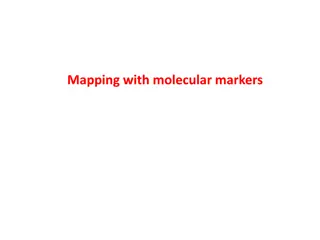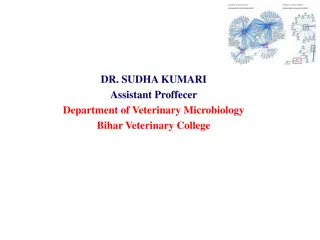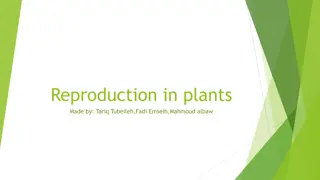Understanding Genetic Principles Through Clam Reproduction
Explore the concept of allele inheritance using beads as gametes, relating it to clam reproduction. Discuss gamete fusion probabilities, Hardy-Weinberg Equilibrium, and frequency predictions in population genetics.
Download Presentation

Please find below an Image/Link to download the presentation.
The content on the website is provided AS IS for your information and personal use only. It may not be sold, licensed, or shared on other websites without obtaining consent from the author. Download presentation by click this link. If you encounter any issues during the download, it is possible that the publisher has removed the file from their server.
E N D
Presentation Transcript
Welcome fellow clams! You all grabbed a handful of beads Each bead represents an allele from a gamete How did your handful compare to those around you? Did you all grab the same amount and the same colors? What does your handful suggest about your genotype at that locus? Why is this like clam reproduction?
Gametes Individuals Will all gametes fuse in broadcast spawning? If gametes fuse, will they always develop and become adults? Can we predict the genotypes in the next generation from the gamete pool? Things we need to define first! What is an allele/gene/genotype? How many alleles does an individual have at a given locus?
Probabilities of gametes fusing Our total alleles in the gamete pool are Red (A) = _______ fA= _______ Yellow (a) = _______ fa= _______ What is the probability of two red (A) gametes fusing? What is the probability of two yellow (a) gametes fusing? What is the probability of a red (A) and yellow (a) gamete fusing, in any order?
Using Hardy-Weinberg to make predictions We counted up our alleles as you were walking in Known = allele frequencies in the gamete pool What is Hardy-Weinberg Equilibrium? Null hypothesis No Evolution! If there is no evolution, then what are the assumptions of HWE? Large, randomly mating population, No selection, No genetic drift, No mutation, and No migration (gene flow). If the assumptions are not met, then Allele frequencies will change from one generation to the next (evolution), thus we may not be able to predict genotype frequencies using allele frequencies
Probabilities Hardy-Weinberg Hardy-Weinberg Equilibrium is simply probability What is the HWE equation? p2+ 2pq + q2= 1 We have two alleles in our population. They are p and q. The frequency of them add to 1. p= fA= _______ (remember p+q=1) q = fa= _______ Probability of two red (A) gametes fusing = p2 Probability of two yellow (a) gametes fusing = q2 Probability of a red (A) and yellow (a) gamete fusing (in any order) = 2pq
Frequency predictions counts We now have our predicted frequencies. How do we figure out how many individuals in a population are expected of each genotype? Let s say the population is 30 individuals Genotype Frequency Count expected AA Aa aa Genotype frequency x population size
Testing our predictions Take a sample from the gamete pool Grab enough alleles for two individuals Make sure that you pull two alleles at a time Record the genotypes of your individuals Our population: AA= Aa= aa= fAA= fAa= faa= What are the allele frequencies in our population? fA= fa=
How can we tell if evolution happened? Did we violate the H-W assumptions? Need to do a Chi-square test. degrees of freedom: df = k 1 m k: number of classes m: number of independent allele frequencies estimated
Chi-square test What are our observed and expected values? Genotype Observed Expected O-E (O-E)^2 ((O-E)^2)/E AA Aa aa sum
Chi-square test Your chi-square test statistic: d.f.= k-1-m = 3-1-1=1
What would happen if we continued spawning... Generation after generation? If we don t violate H-W assumptions then no evolution in our population. Therefore, H-W is our null model!
Practice! If you have a population of clams in which p=0.25, q=0.75 . What is the probability that you get a heterozygous individual? What is the probability that you will get a homozygous individual? If you have a population of clams in which AA=53, Aa=16, aa=5 . What are genotype frequencies in the population? What are the allele frequencies? Do these observed values deviate from the expected values, given the allele frequencies? Do the chi-square test.
Welcome back fellow clams! Last time we reviewed Hardy-Weinberg Equilibrium Today we are investigating how deviations in HWE can change allele frequencies. Instead of working as a whole class population, you are working in groups of 3 as unique population.
Populations of Mya arenaria (soft-shelled clams) 5 populations Havre-Aubert, QC Lawrencetown, NS Lepreau Basin, NB Essex, MA Orleans, MA
Materials and Procedures Each group should have a bag of red and yellow marbles, 100 of each color population tray (ice cube tray) with 24 labelled wells Access the GoogleSheets link Blackboard site Course Documents Clams Activity link Each group is a population of 24 individuals that die and replace themselves every generation On average each individual produces approximately 8 or more gametes the gamete pool is limited to approximately 200 gametes each generation
Initial allele frequencies & making predictions All populations have 100 red (A) and 100 yellow (a) beads Remember that each bead represents an allele in a gamete What are the allele frequency of the gametes? fA= p = ______ Fill this out on your worksheet and in your GoogleSheet in the Generation 0 row Hint: Make sure that you are on the correct Population GoogleSheet Predict the genotype counts in the next generation Determine genotype frequencies first (using allele frequencies) fAA= p2= ______ fAa= 2pq = ______ Multiply the genotype frequencies by the population size to get predicted counts in a population of 24 individuals AA= p2x N = ______ Aa=2pq x N =______ Record your predictions on your worksheet. fa= q = ______ faa= q2= ______ aa= q2x N = ______
Generation 1 - before event Pull 24 individuals. Clams are diploid pull two gametes at a time Place each individual (two gametes) into the numbered tray Count all genotypes Record sum counts in your GoogleSheet Calculate allele frequencies in your GoogleSheet We will use formulas! But, are these the breeders for the next generation? Do they all survive to adulthood and produce offspring?
Generation 1 - after event Draw one event card from your population deck. Read it follow it manually remove any necessary individuals from your tray Place the used card off to the side The population after the event is the population of contributing breeders into the next generation Calculate allele frequencies of the breeder population Are these allele frequencies different from the before event population? Readjust your gamete pool based on these allele frequencies Use short cut formulas to reduce counting time
Continue for about 6 generations (may be more) Pull 24 individuals (2 alleles at a time from the gamete bag) and place individuals into each well of the population. Record genotype counts and calculate allele frequencies in the before event row for that generation. Draw one event card and follow the instructions. Record genotype counts and calculate allele frequencies in the after event row for that generation. The individuals remaining will contribute gametes into the next generation. Calculate allele counts to be used to create a gamete pool of 200. Empty the gamete bag of all gametes from the previous generation and make your new gamete pool. Repeat until you reach Generation 11.
Final allele frequencies Compare initial and final allele frequencies. Draw a figure depicting changes in allele frequencies over time. Determine if there is a significant difference between the first and final populations using a Chi- square test (see your notes from last time and your hints on your worksheet). Generate a conclusion about evolution in your population.
Comparing populations Your group should have at least one person from each population. Follow the worksheet to compare populations, trends, and environmental conditions. Did all populations experience the same environmental conditions? How did the environmental conditions affect population genetics of the population?
Havre- Aubert Havre- Aubert Havre- Aubert It s a beautiful day to spawn! Last one in the spawning pool is a rotten egg! It s a beautiful day to spawn! Last one in the spawning pool is a rotten egg! It s a beautiful day to spawn! In the spawning confusion some gametes did not find each other! Only the last compartment doesn t make it into the breeding population!! The last compartment doesn t make it into the breeding population!! The middle compartment (number 12) doesn t make it into the breeding population!! Havre- Aubert Havre- Aubert Havre- Aubert It s a beautiful day to spawn! The early bird does not always get the worm! It s a beautiful day to spawn! In the spawning confusion some gametes did not find each other! It s a beautiful day to spawn! The early bird does not always get the worm! The first compartment doesn t make it into the breeding population!! The first compartment doesn t make it into the breeding population!! The middle compartment (number 12) doesn t make it into the breeding population!!
Havre- Aubert Havre- Aubert DREDGING ACCIDENT: A fishing boat accidentally drags a dredge through your population. 15% of the clam population dies. INVASIVE COMPETITOR: A new species is introduced and it competes for your population s resources. 20% of the clam population dies. Remove individuals from every sixth compartment from the breeding population. Remove individuals from every fifth compartment from the breeding population. Havre- Aubert Havre- Aubert STORM WARNING: A massive storm comes through bringing high tides, rough waves, and excessive sand. 25% of the clam population dies. PREDATOR ATTACK: Sea stars have found your population! 10% of the clam population dies. Remove individuals from every eighth compartment from the breeding population. Remove individuals from every third compartment from the breeding population
Lawrencetown Lawrencetown Lawrencetown It s a beautiful day to spawn! Last one in the spawning pool is a rotten egg! It s a beautiful day to spawn! Last one in the spawning pool is a rotten egg! It s a beautiful day to spawn! In the spawning confusion some gametes did not find each other! Only the last compartment doesn t make it into the breeding population!! The last compartment doesn t make it into the breeding population!! The middle compartment (number 12) doesn t make it into the breeding population!! Lawrencetown Lawrencetown Lawrencetown It s a beautiful day to spawn! The early bird does not always get the worm! It s a beautiful day to spawn! In the spawning confusion some gametes did not find each other! It s a beautiful day to spawn! The early bird does not always get the worm! The first compartment doesn t make it into the breeding population!! The first compartment doesn t make it into the breeding population!! The middle compartment (number 12) doesn t make it into the breeding population!!
Lawrencetown Lawrencetown DREDGING ACCIDENT: A fishing boat accidentally drags a dredge through your population. 15% of the clam population dies. INVASIVE COMPETITOR: A new species is introduced and it competes for your population s resources. 20% of the clam population dies. Remove individuals from every sixth compartment from the breeding population. Remove individuals from every fifth compartment from the breeding population. Lawrencetown Lawrencetown STORM WARNING: A massive storm comes through bringing high tides, rough waves, and excessive sand. 25% of the clam population dies. PREDATOR ATTACK: Sea stars have found your population! 10% of the clam population dies. Remove individuals from every eighth compartment from the breeding population. Remove individuals from every third compartment from the breeding population
Lepreau Basin Lepreau Basin Lepreau Basin It s a beautiful day to spawn! Last one in the spawning pool is a rotten egg! It s a beautiful day to spawn! Last one in the spawning pool is a rotten egg! It s a beautiful day to spawn! In the spawning confusion some gametes did not find each other! Only the last compartment doesn t make it into the breeding population!! The last compartment doesn t make it into the breeding population!! The middle compartment (number 12) doesn t make it into the breeding population!! Lepreau Basin Lepreau Basin Lepreau Basin It s a beautiful day to spawn! The early bird does not always get the worm! It s a beautiful day to spawn! In the spawning confusion some gametes did not find each other! It s a beautiful day to spawn! The early bird does not always get the worm! The first compartment doesn t make it into the breeding population!! The first compartment doesn t make it into the breeding population!! The middle compartment (number 12) doesn t make it into the breeding population!!
Lepreau Basin Lepreau Basin Lepreau Basin RED TIDE OUTBREAK: Local toxigenic dinoflagellate (Alexandrium spp.) populations bloom. Clams feed on these toxic plankton. Many of the clams that are susceptible to the toxin do not survive. RED TIDE OUTBREAK: Local toxigenic dinoflagellate (Alexandrium spp.) populations bloom. Clams feed on these toxic plankton. Many of the clams that are susceptible to the toxin do not survive. RED TIDE OUTBREAK: Local toxigenic dinoflagellate (Alexandrium spp.) populations bloom. Clams feed on these toxic plankton. Many of the clams that are susceptible to the toxin do not survive. Remove the 50% of the homozygous recessive individuals. Remove 10% of the homozygous recessive individuals. Remove 75% of the homozygous recessive individuals. Lepreau Basin RED TIDE OUTBREAK: Local toxigenic dinoflagellate (Alexandrium spp.) populations bloom. Clams feed on these toxic plankton. Many of the clams that are susceptible to the toxin do not survive. Remove 25% of the homozygous recessive individual.
Essex Essex Essex It s a beautiful day to spawn! Last one in the spawning pool is a rotten egg! It s a beautiful day to spawn! Last one in the spawning pool is a rotten egg! It s a beautiful day to spawn! In the spawning confusion some gametes did not find each other! Only the last compartment doesn t make it into the breeding population!! The last compartment doesn t make it into the breeding population!! The middle compartment (number 12) doesn t make it into the breeding population!! Essex Essex Essex It s a beautiful day to spawn! The early bird does not always get the worm! It s a beautiful day to spawn! In the spawning confusion some gametes did not find each other! It s a beautiful day to spawn! The early bird does not always get the worm! The first compartment doesn t make it into the breeding population!! The first compartment doesn t make it into the breeding population!! The middle compartment (number 12) doesn t make it into the breeding population!!
Essex Essex Essex RED TIDE OUTBREAK: Local toxigenic dinoflagellate (Alexandrium spp.) populations bloom. Clams feed on these toxic plankton. Many of the clams that are susceptible to the toxin do not survive. RED TIDE OUTBREAK: Local toxigenic dinoflagellate (Alexandrium spp.) populations bloom. Clams feed on these toxic plankton. Many of the clams that are susceptible to the toxin do not survive. RED TIDE OUTBREAK: Local toxigenic dinoflagellate (Alexandrium spp.) populations bloom. Clams feed on these toxic plankton. Many of the clams that are susceptible to the toxin do not survive. Remove the 50% of the homozygous recessive individuals. Remove 10% of the homozygous recessive individuals. Remove 75% of the homozygous recessive individuals. Essex RED TIDE OUTBREAK: Local toxigenic dinoflagellate (Alexandrium spp.) populations bloom. Clams feed on these toxic plankton. Many of the clams that are susceptible to the toxin do not survive. Remove 25% of the homozygous recessive individual.
Orleans Orleans Orleans It s a beautiful day to spawn! Last one in the spawning pool is a rotten egg! It s a beautiful day to spawn! Last one in the spawning pool is a rotten egg! It s a beautiful day to spawn! In the spawning confusion some gametes did not find each other! Only the last compartment doesn t make it into the breeding population!! The last compartment doesn t make it into the breeding population!! The middle compartment (number 12) doesn t make it into the breeding population!! Orleans Orleans Orleans It s a beautiful day to spawn! The early bird does not always get the worm! It s a beautiful day to spawn! In the spawning confusion some gametes did not find each other! It s a beautiful day to spawn! The early bird does not always get the worm! The first compartment doesn t make it into the breeding population!! The first compartment doesn t make it into the breeding population!! The middle compartment (number 12) doesn t make it into the breeding population!!
Orleans Orleans Orleans RED TIDE OUTBREAK: Local toxigenic dinoflagellate (Alexandrium spp.) populations bloom. Clams feed on these toxic plankton. Many of the clams that are susceptible to the toxin do not survive. RED TIDE OUTBREAK: Local toxigenic dinoflagellate (Alexandrium spp.) populations bloom. Clams feed on these toxic plankton. Many of the clams that are susceptible to the toxin do not survive. RED TIDE OUTBREAK: Local toxigenic dinoflagellate (Alexandrium spp.) populations bloom. Clams feed on these toxic plankton. Many of the clams that are susceptible to the toxin do not survive. Remove the 50% of the homozygous recessive individuals. Remove 10% of the homozygous recessive individuals. Remove 75% of the homozygous recessive individuals. Orleans RED TIDE OUTBREAK: Local toxigenic dinoflagellate (Alexandrium spp.) populations bloom. Clams feed on these toxic plankton. Clams that are susceptible to the toxin do not survive. Remove 25% of the homozygous recessive individual.























